PeekMed
Orthopedic surgery has long focused on fixing what’s broken. We replace joints, repair tendons, and stabilize fractures. And it works. But what if instead of replacing damaged tissue, we could help it heal itself?
That’s the promise of regenerative orthopedics. It’s a shift from reconstruction to restoration, using cells, growth factors, and scaffolds to encourage natural tissue repair. The idea is simple but powerful: give the body the tools to fix what’s wrong, and let biology do the work.
Here’s what’s happening now, what’s coming next, and how your digital planning tools can prepare you for this future.
What is Regenerative Orthopedics?
Regenerative orthopedics uses biologic therapies to restore musculoskeletal tissue. We’re talking about cartilage, bone, tendons, ligaments, and even intervertebral discs. It involves stem cells, platelet-rich plasma (PRP), bone marrow aspirate concentrate (BMAC), growth factors, and bioactive scaffolds. Surgeons inject, implant, or place these agents in areas of injury to jump-start healing.
What’s Ready Now vs. What’s Experimental
Some treatments are already here. PRP injections, BMAC for bone healing, and autologous chondrocyte implantation (ACI) are currently in use. They’re not perfect, but they offer biological alternatives when mechanical solutions are not feasible.
Other strategies are still in trials. Stem-cell–based cartilage regeneration, gene-modified cells, and immunomodulatory scaffolds are exciting but still experimental. Evidence is growing, but indications and outcomes need more clarity.
Where Digital Planning Fits In
Even biology needs a plan. Regeneration requires knowing exactly where and how much tissue to treat. Patient-specific 3D models define defect size, shape, and orientation. They help map out precise delivery of biologics, guide scaffold placement, and combine mechanical correction with biological repair.
This is where PeekMed comes in. The planning you already do, mapping osteotomies, defining graft sizes, and aligning mechanical axes, builds a foundation for regenerative procedures. When biologics are ready, you’ll have the workflow in place.
Want to see how planning already improves patient-specific care? Check our related post: 3D Printing in Orthopedics.
Challenges Surgeons Should Know
Regenerative orthopedics is promising, but not simple. Regulatory pathways are evolving. Costs are high, and reimbursement is inconsistent. The surgical learning curve is steep. And long-term data is limited.
Still, the direction is clear. More therapies are moving from bench to bedside. The role of precision planning will only grow.
Takeaways for Surgeons
- Stay updated on clinical evidence.
- Combine biologics with sound mechanical principles.
- Use digital planning tools now: they’ll be essential for future biologic workflows.
The tools you use today can set you up for the next step in orthopedic care: helping patients heal with their own biology.
Ready to explore what PeekMed can do? Visit PeekMed and see how surgical planning is shaping the future of orthopedics.



